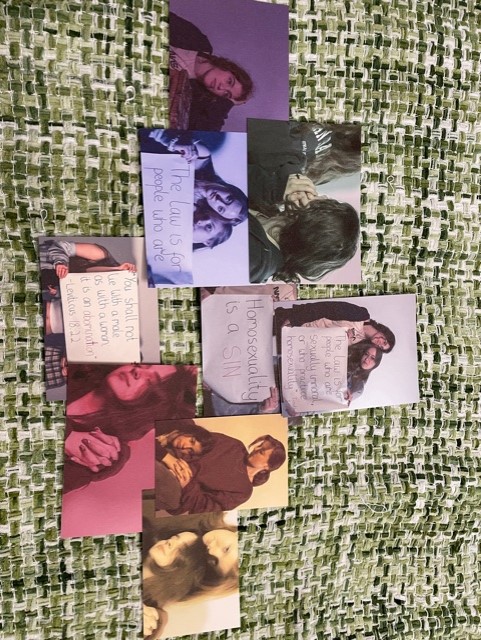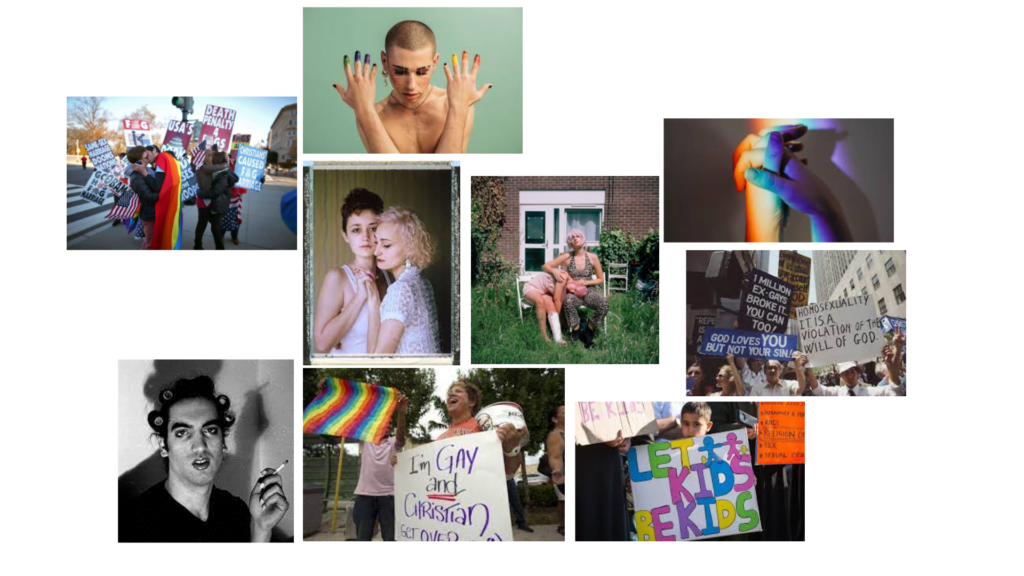To start off the image, i first lay out the photos in different ways and shared them with the group, this was to ensure that the rest of the group were happy with our final image. I chose the same colour thread as the tint of each image, reinforcing the colours that represent the LGBTQ flag as some of the colours faded slightly as a result of the images being printed on a thicker paper, allowing embroidery without tearing. I first, embroided the photos separately, ranging the patterns and density of the thread. I went on to sew the images onto a piece of a2 sized fabric, that acts as the background to the collage. I also glued down some photos and lose edges to de-clutter the piece, making it looked neater. once the piece was together, I then framed it on a window mount to flatten it and keek it stretched.
All posts by Bethany M
Filters
EMBROIDERY and sequencing
“Photograph is drawing with light, like embroidery is drawing with thread”
Recently, we participated in a workshop ran by an artist, Julia. Within this course, we experimented with different styles of threading and embroidering to add colour, texture, emotion and richness.
To start the workshop, I looked through the book ‘The intentional thread’ by Susan Brandeis which takes u through different techniques and expressions that can be used to demonstrate atmospheres, feelings and even weather. I especially liked the sections where Brandeis showed how to embryoid these techniques, using step by step instructions to show readers how to execute their desired looks.
artist reference : still image
Carol Benitah
Benitah is a French visual creator UN agency worked for 10 years as a dressmaker before turning to photography in 2001, exploring memory, family and therefore the passage of your time. usually pairing recent family photos with skilled worker accents, like embroidery, beads and ink paintings, Benitah seeks to reinterpret her own story as a girl, married woman and mother.
By activity totally different faces and options, the folks photographed are nearly stripped of their identity. I selected to check Benitah as a result of I believe his art best represents the construct I hope to capture during this project.

With beads, coloured thread and scissors, French photographer Carolle Benitah has altered her family photo albums to explore the memories of her childhood, and as a way to help her understand her current identity.
Carolle herself has said:
I started to be interested in my family pictures when I was leafing through a family album and found myself overwhelmed by an emotion of which I could not define the origin.
These photographs were taken 40 years earlier, and I could not even remember the moments they were shot, nor what preceded or followed those moments.
But the photos reawakened an anguish of something both familiar and totally unknown, the kind of disquieting strangeness that Freud spoke about. Those moments, fixed on paper, represented me, spoke about me and my family, told things about my identity, my place in the world, my family history and its secrets, the fears that constructed me, and many other things that contributed to who I am today.
I decided to explore the memories of my childhood to help me understand who I am and to define my current identity.
To begin, I carry out “excavations”. Like an archeologist, I dig out the pictures in which I appear from family albums and the shoe boxes full of photographs. I choose snapshots because they are related to memories and to loss.
These photographs are fragments of my past. I interpret them from a subjective perspective as confessions. I order them, classify them, scan them, then I print them. I don’t do anything directly on the original photo; I transpose this reality on a different paper. Sometimes I crop a detail that calls out to me, and I choose my format. The work of interpretation begins with these steps.
Once these choices of images are made, I start to tell my version of the story. I turn my attention to my own history, sometimes with 40 years of distance and the life experiences that changed my perception of events. The past of a human being, unlike the remains of an antique temple, is neither permanent nor finished, but reconstructed in the present time.
For the next step, I add needlework: embroidery and beads.
Embroidering is primarily a feminine activity. In the past, the embroiderer was seen as a paragon of virtue. Waiting was tied to this activity: women embroidered, hoping for the return of the man to the home. Embroidery is intimately linked to the milieu in which I grew up. Girls in a “good family” used to learn how to sew and embroider — essential activities for “perfect women”. My mother embroidered her trousseau.
There is nothing subversive about this activity, but I pervert it with my purpose.
I use its decorative function to re-interpret my own history and to expose its failings.
The two activities — interpretation and needlework — come together again in a kind of dispute: embroidery is the sign of a good education yet the words that I speak don’t show me to be what I was supposed to be: a well behaved girl, a wise spouse and a loving mother.
With each stitch I make a hole with a needle. Each hole is a putting to death of my demons. It’s like an exorcism. I make holes in paper until I am not hurting any more.
– Carolle Benitah
Benitah’s work is linked to ours as both share the nature of hand-stitching images to tell a story or present an idea through embroidery
story board
A storyboard is a collection of images in a certain order to portray a concept someone wishes to execute in their film.
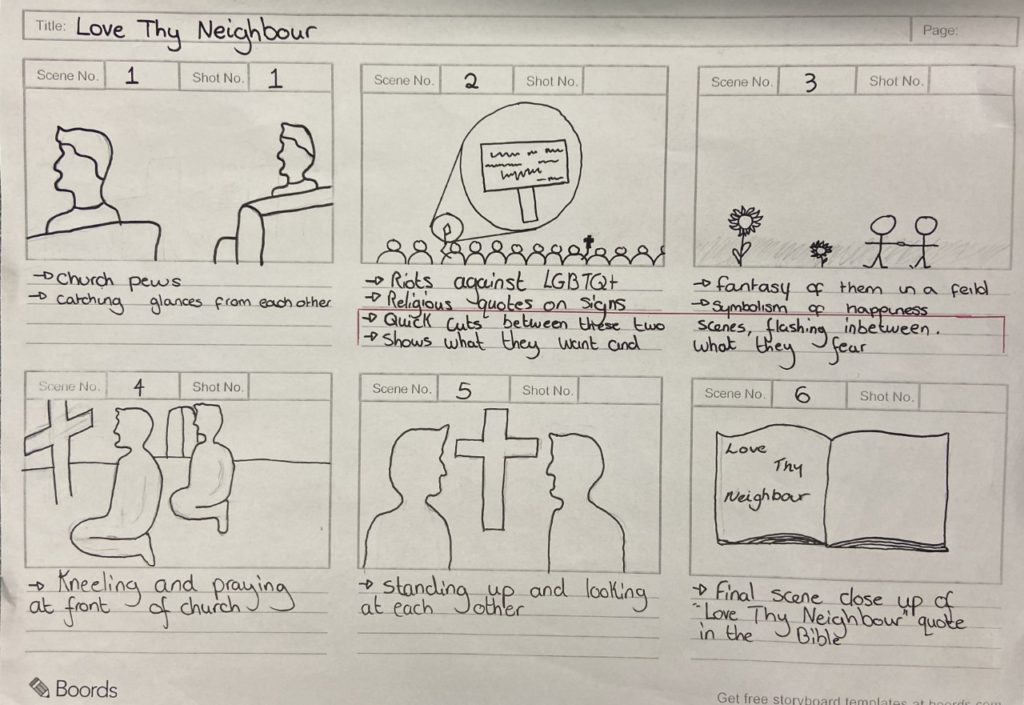
The first picture illustrates the idea of the film containing same-sex actors within a church, sharing looks and doing personal readings of the bible, at a distance. We then wish to find authentic clips of old riots/protests against LGBTQ rights to use in the middle of the film, this is to project a clearer idea to the audience and adds a real element to the film, showing that is actually happens in real life. We will be flicking these clips in-between dazed, over exposed fantasy scenes that we will shoot in an open field with natural lighting. The aim of the middle is to show the thoughts of the pair if they wish to pursue a homosexual relationship, thinking of both negative and positive impacts on their lives, considering religion.
To end the film, we will direct the couple to move to sit together, there then they will compare positive verses they have both found. This is to show that they are supporting each other, helping to show the other how to accept their sexuality.
To link back to the title and topic, we will present the verse which states ‘love thy neighbour’ as a close up. We chose this verse as it can be interpreted as an umbrella for christianity to encourage all to accept those for who they are, de-stigmatising learnt prejudice from society.
Bayeux Tapestry
The Bayeux Tapestry tells the story , in wool thread embroidered on linen cloth, of William, Duke of Normandy who became King of England in 1066 after the Battle of Hastings. Crossing the sea in longships, long cavalcades on horseback, shields and coats of mail, fantastic creatures and battlefields. There are 58 scenes, 626 characters and 202 horses embroidered on the tapestry. This battle is told through the gruesome and detailed embroidery, displaying a bloody battle full of severed limbs, falling horses and the defeat of Harold caused by an arrow being shot in his eye, according to the Anglo-Norman tapestry.
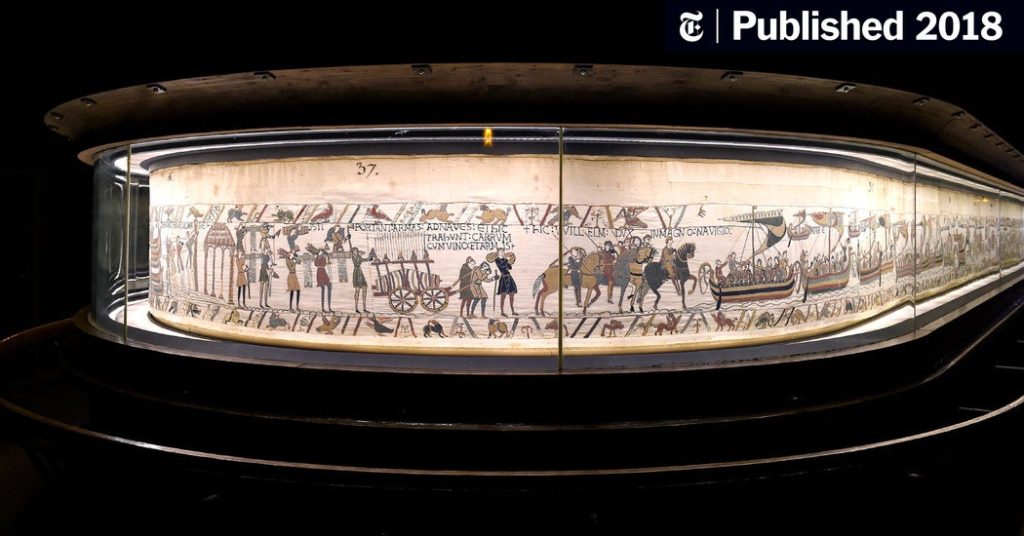
Warriors from Jersey are rumoured to have fought in the battle beside Normandy, resulting in Jersey and the other channel islands joining the Anglo-Norman realm following the defeat of King Harold by William the Conqueror and won the English crown at the Battle of Hastings in 1066.

nft research
A NFT is a non- fungible token, the token is an object built on the Blockchain, non fungible means unique. This allows people to share, trade and transport these NFTs through the metaverse. The metaverse is a virtual universe in which all online resources and products, such as the internet, augmented reality, NFTs and more, are in a shared space. The electronic platform allows more opportunities for artists’ work to be seen and sold on a wider scale. Due to the blockchain, the artists also get a percentage of profits in the metaverse.
The 2lives movement was created with this technology, with the purpose to promote the world of NFTs to the population of Jersey. Being open to everyone, from those artists who hope to further their viewings and platforms to the general public who enjoy trading and collecting art. Our class had the amazing opportunity to attend a zoom call with the creators of 2lives, Francesco Vincenti and Claudia Runcio, over in Italy. Where we got the chance to hear first hand the importance of opening up the metaverse , promoting what can be a global community and asking any questions we had.

statement of intent
Concept: What will the future of Jersey look like as a community in the metaverse?
3 WORDS: United, Peaceful, Diverse
A SENTENCE: A place where an individual feels respected and comfortable in being who they are.
A PARAGRAPH: Regarding all communities in our mind map, our group decided to focus in on the relationship between the religious community and the LGBTQ+ community as we all know the conflicts those communities have. A metaverse can be described as a potential utopia, so we want to construct a united metaverse between all communities where we all live in harmony.
Content
In our film, we want to show the thoughts and fears of a young man that is conflicted between his religion and sexuality, using scenes of a riot like environment to portray the negative fears and connotations of a happy relationship to show the reward.
mood board
mind map
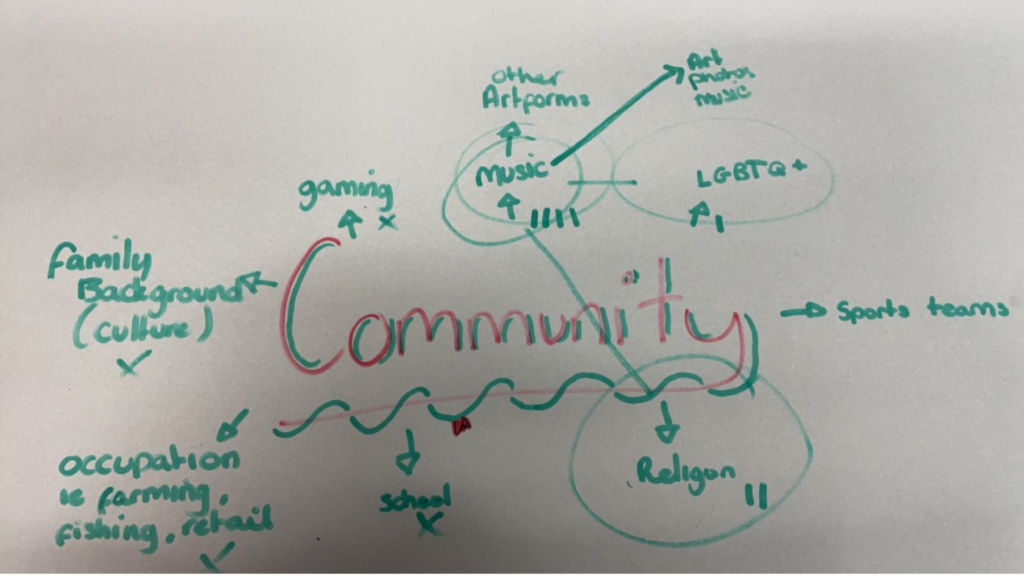
Evaluation
In my opinion, i feel as if my overall outcomes of the project are successful. My original intentions were to present a concept to the viewer in the rapid increase Anthropocene has on the planet. The whole process of my project was quite up and down throughout the experience.
Following my intentions, I am happy that i decided to do a second shoot (binary opposites) as i feel that it complements my first shoot quite nicely, this being that it is a genuine example of the change Anthropocene has, showing that it’s actually happening and not something we can ignore. I hope this raises a question in viewers that if this is the difference in so many years, what will Jersey look like in a later era with the growing rate of pollution?
I am very happy that for this project, I looked for an idea first then an artist, this made an easier start which allowed me to flow through the requirements a lot smoother, giving me a better sense of direction in which task to progress to first. When it came to taking photographs, the only critique i have would be that i wish i had done more locations for my distorted imagery to give myself more selection.




